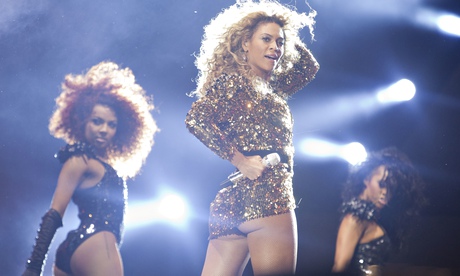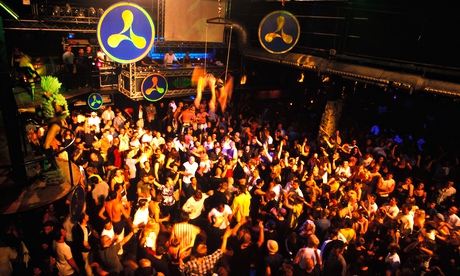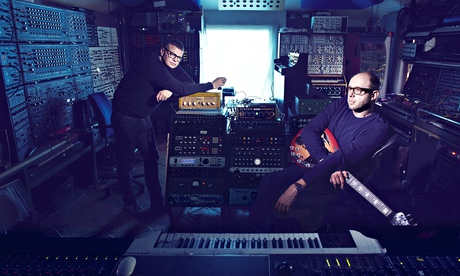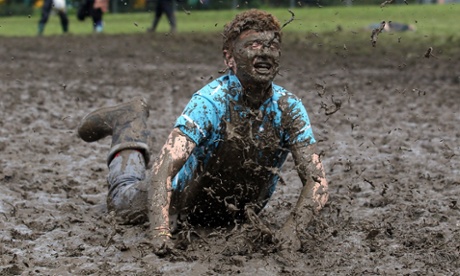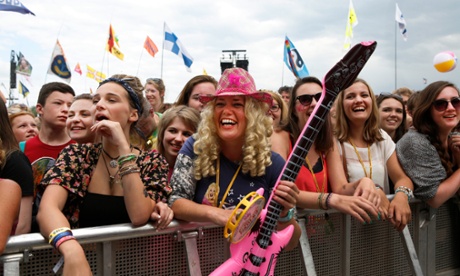1959: The outdoor folk festival begins in the US
The Newport folk festival grew out of the popular Newport jazz festival, a pioneering outdoor summer event founded by promoter George Wein in 1954. It was inspired by classical music festivals that had taken root over the previous century, bringing together middle-class audiences to appreciate high art. Five years later, Wein started the folk festival with a board of musicians that included Pete Seeger, who performed at the first event alongside Joan Baez and Earl Scruggs; the festival would later become famous as the place where Dylan “went electric”. Wein also pioneered corporate sponsorship at gigs, and championed racial integration at his festivals – it spoke volumes that his wife, Joyce, was rarely allowed by his side at other events because she was African American – and he is still involved in the world-famous New Orleans jazz and heritage festival aged 89.
In February, he won a Grammy Trustee award, saying how delighted he was to be on the same roll as late peers such as Atlantic records founder Ahmet Ertegün. However, he added, “I’m not ready to join them yet.”
1961: The UK gets in on the action – starting in a humble athletics ground
A tiny advert on page 12 of the 19 August 1961 edition of Melody Maker announced the arrival of one of the UK’s best-known festivals. Back then, it was the national jazz festival, held for the first five years at the Richmond Athletic ground, before it moved via Plumpton, Windsor and Sunbury to a new site at Reading (in 1971), and lost the jazz in favour of sounds from the murkier worlds of blues, prog and rock. Reading became the country’s leading rock festival, before its site was “reclaimed for redevelopment” by a Conservative council in the mid-1980s for two years, and licences allowing the event to relocate were refused. Labour won the next election, and the rock soon returned. Reading relaunched as a more alternative offering in 1989, with New Order, My Bloody Valentine and Swans on the bill. It gained a northern outpost at Leeds in 1999, and now hosts more than 160,000 people on the same August bank holiday weekend.
1970: Isle of Wight chaos leads to notoriety; meanwhile on a Somerset farm…
The exotic spirit of the Monterey pop festival, Woodstock and late-60s psychedelic gigs led to 600,000 revellers decamping to the Isle of Wight in August 1970. NME reported on the resulting tabloid frenzy: “While the national press vied with each other to give readers more and more sensational stories concerning drugs, battles on Devastation Hill, nude bathing, babies on the site, losses by the promoters, lack of security, too much security, French-Algerian rebels joining with Hell’s Angels… NME writers were listening to the music to bring you this report. It isn’t complete because the timing went haywire, and some artists appeared as late as 4am. Sly and the Family Stone came on at dawn on Sunday…”
The Isle of Wight Act was set into law a year later, to counter “the adverse impact upon residents and the environment of large-scale assemblies”. Jimi Hendrix famously played his last British gig at that 1970 event; he was dead three weeks later, one day before another festival started on a Somerset farm. There, tickets cost a pound, milk was free and ox roast was readily available. FRoots magazine editor and then-folk singer Ian Anderson remembers the Pilton pop and blues festival fondly: “[It was] nicely ramshackle, not many people, Afghan coats, loon pants, minimal security… very simple, amateurish, in the nicest sense, and hospitable. A few bemused-looking bikers, the odd burger van, lots of grass – the green sort, and the other kind!” In a 2013 interview, Michael Eavis thanked Anderson for saving the first Glastonbury festival when he got up and played to the crowd after T Rex turned up late. Despite those plaudits, and those memories, Anderson has never returned to Glastonbury. “I imagine I might find it a bit overwhelming.”
1980: Donington roars into life
The 1980s were a mixed time for music festivals, but Monsters of Rock was one of the decade’s big successes. Set on the Donington Park motor-racing circuit in Leicestershire – handily near the M1 – Monsters of Rock started muddily, with two years of rain and sludge. Heavy-hitters such as AC/DC, Whitesnake and Judas Priest brought out tens of thousands of headbangers regardless. The UK Rock Festivals site is full of oral histories on the event (and indeed many others): highlights include toilets consisting of scaffold poles with canvas sheets strung between them, countless flying bottles of urine, and Lemmy “threatening to fight the idiot who threw a lighted flare at him during the Motörhead set” in 1986. Monsters of Rock imploded in the mid-1990s as heavy metal fell out of fashion, but another festival, Download, began at Donington in 2003, and still thrives.
1984: Moz and co kickstart an indie invasion
The arrival of an indie group on the Pyramid Stage in 1984 was seen as a watershed for Glastonbury’s programming, according to Michael Eavis. He told the BBC in 2009 that most punters expected Santana back then rather than the Smiths. “Morrissey was actually beckoning [fans] up onstage, and when I saw that, I knew then the whole thing had changed into something else,” he remembered. “There was no place for the Santana audience any longer, we’d gone into pop.”
Music journalist Steve Jelbert was one of the Smiths fans who got on stage that day. “The old stage had no pit between the punters and the bouncers, but it was very high, and made of sloping corrugated metal. Fuck knows how we threw ourselves up it, but a few of us did.” He also thought the Smiths were a good fit for the festival, being supportive of leftwing causes. “The only thing unusual was that they were young and up-and-coming, which meant that the old lags might not have heard of them.”
They weren’t treated like kings, though; they had to go on earlier than scheduled (because ska band Amazulu’s van had broken down), and they had their set cut to 25 minutes.
1990: The battle of Yeoman’s bridge exposes a divide
The Monday after the Glastonbury weekend in 1990, a fight broke out between Glastonbury’s on-site security team and the Travellers who had been given their own, free festival fields just beyond the site’s borders for years. Journalist Andy Fyfe, then at NME, remembers it as being a scary experience. “The whole Travellers’ field was a living hell. Just through the entrance under the old railway track was a toothless woman screaming, ‘Bad acid, get your worst nightmare here’, while her baby crawled around in puddles… We were trying to get a van out but all the roads and gates were closed as the riot went on around us. Everyone who wasn’t involved just sat around waiting for the moment when we’d get pulled into the melee. Luckily, it never happened.” Some of the Travellers there that year are now involved in the running of the “alternative” Lost Vagueness/Shangri-La fields at Glastonbury, Fyfe says, which are “a sanitised version of the old Travellers’ field, really”. Glastonbury was cancelled in 1991 as a consequence of the Yeoman’s bridge battle, and the jumpable fences around the site began to get higher and stronger, Michael Eavis’s “super-fence” finally being unveiled in 2002.
1992: Castlemorton controversy leads to the Criminal Justice Act
Free outdoor parties mushroomed with the rise of acid house in 1988, but most of them were illicit, late-night, secret affairs. Castlemorton happened when convoys heading for the site of the Avon free festival in Chipping Sodbury, Gloucestershire, were turned back by police, and gathered instead at Castlemorton Common at the foot of the Malvern Hills. For nearly a week, ravers and new-age travellers partied to soundsystems 24 hours a day. Melody Maker’s Simon Reynolds marvelled at how lax the police presence was: “Few police ventured into the festival throng. When I arrived, a pair of genial bobbies were strolling around the periphery merely directing drivers to parking places.”
There was no violence reported, only 70 arrests (mostly for drug-related offences) and the area suffered no permanent environmental damage. Nevertheless, the Criminal Justice and Public Order bill started being drafted a few months later, and came into law in 1994. Official dance music festivals, such as Tribal Gathering and Global Gathering, multiplied and Glastonbury itself installed its first official dance tent in 1995.
1994: Michael Eavis takes a punt on live TV – and takes Glasto to another level
In 1993, Tyne Tees Television and Channel 4 approached Michael Eavis about televising Glastonbury. He liked their ideas, and took on a lawyer they recommended, Ben Challis, who had worked on the Prince’s Trust Rock Galas; he also liked the fact he knew people who worked at Glastonbury already. “I met Michael at Worthy Farm,” Challis remembers, “and he showed me around, stopping off mid-tour to do some water divining, which was fairly surreal. He also seemed to like the fact I kept chickens and grew rhubarb and plums.” Eavis knew live TV was a risk, Challis adds, but was keen to get his weekend out to new audiences; Glastonbury TV, the company, was born.
The festival was first televised by Channel 4 in 1994; by 1995 Challis was aware that TV “had taken Glastonbury to another level – not least as demand for the already sold-out tickets soared. All of a sudden I had neighbours commenting on how brilliant it all looked, and asking for tickets and backstage passes.” He noticed the influence Glastonbury had on record sales too; acts still sign on the dotted line today because they know the effect being broadcast into so many homes can have.
Challis recalls: “I remember in 1994 me and our producer Caroline spent most of the time running between the Pyramid Stage and the Other Stage getting bands to agree to the filming and sign off clearance forms – that’s all different now!”
Glastonbury TV now broadcasts across BBCs 2, 3 and 4 and BBC radio, and is the station’s most popular red-button programme – not that Challis has a chance to see much. “I miss so much on site, I watch most of it on the iPlayer!”
1999: Cool kids ditch mud and tents at Pontins weekend
“I was never very interested in actual festivals; I was a bit bemused by them. I couldn’t understand why anyone would want to spend three days in a field, knee-deep in mud.”
So said former holiday camp worker Stuart Murdoch, who in 1999, along with his bandmates in Belle and Sebastian, set up a music festival at Pontins in Camber Sands, East Sussex. Chalets replaced tents, and bands stayed at them too, side-by-side with their fans, bringing civility and intimacy to the festival experience.
Promoter Barry Hogan helped the band organise the weekend, later setting up the All Tomorrow’s Parties brand, and running similar band-curated festivals since. Murdoch wrote about the original Bowlie Weekender for the Guardian in 2013. “I didn’t stop for the whole weekend. I felt like Mother Superior running about, and by the time our gig came around it was a bit of a struggle to play; we were already rushed off our feet trying to make sure everything else was going to plan.” But it did, and Bowlie 2 even happened in 2010, selling out quickly.
2001: Cheap flights and bad weather create booming European market
A perfect storm of factors at the start of the 21st century saw British music-lovers looking overseas for their festival kicks. First, the EU’s deregulation of the aviation industry in the late 1990s saw cheap air routes on the rise, while internet booking made ticket-buying competitive – and in the cases of lines such as Ryanair, cheap. New festivals such as Exit in Serbia (since 2000) and Primavera Sound in Barcelona (2001) also started getting huge headliners, at much cheaper prices than their British equivalents. Add the much higher likelihood at home of mud, rain and cold, and it’s no wonder people headed to the sun instead for their sounds.
2004: Boutique becomes a buzz word
With the big festivals selling out of tickets in record time, and corporate festivals such as V saturating the market with sponsorship, smaller entrepreneurs started to serve the old-fashioned festival punter. Niche audiences were catered for too. The psych-folky Green Man and more eclectic Bestival started in 2004, followed in 2006 by the Americana-heavy End of the Road and the more bookish Latitude. Boutique festivals have also become wildly diverse, featuring literary tents, science fields, festival-wide fancy-dress parades, secret treats and smaller, quirkier crowds.
2011: A female R&B singer headlines Glastonbury
Three years before Beyoncé headlined Glastonbury, she stood in the wings watching her husband, Jay-Z, cause a stir in the top slot. Noel Gallagher was the most famous critic in 2008, saying, “Glastonbury has a tradition of guitar music… I’m not having hip-hop at Glastonbury. It’s wrong.” It’s true that hip-hop had never ruled Glastonbury before, but black performers certainly had: Curtis Mayfield stole the show in 1983, and new music from around the world was as always as well represented as conventional rock. Kanye West’s headlining slot this year is merely a continuation of the same spirit.
Some proclaimed Beyoncé as the first female headliner, but they had short memories. Suzanne Vega was first in 1989, performing in a bullet-proof vest after receiving a death threat from a woman obsessed by one of her band members on the morning of the festival. Sinéad O’Connor, Skunk Anansie and Shakespears Sister also headlined in the 1990s, and Kylie Minogue was set to close the weekend in 2005 before falling ill with breast cancer. Beyoncé’s high-octane, stadium-sized pop did do something new though. Beginning her Pyramid Stage set singing a hippyish chant before emerging from a glowing pyramid, her performance connected festival past and pop’s present – and took Glastonbury into a new, supersized future.
